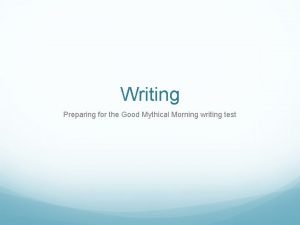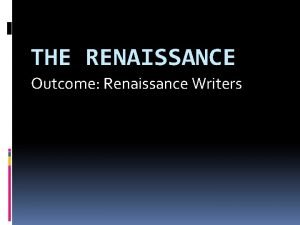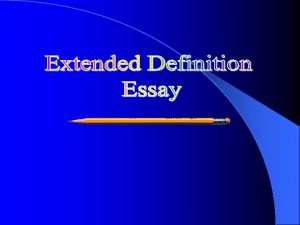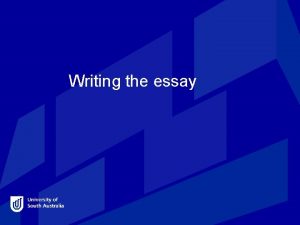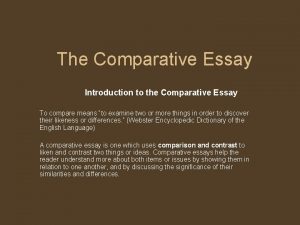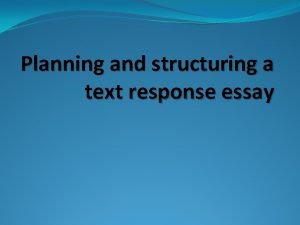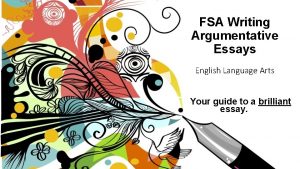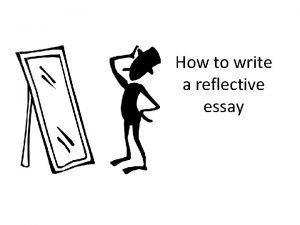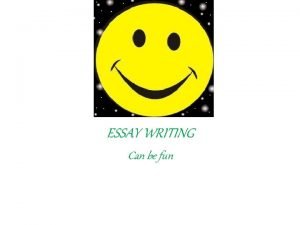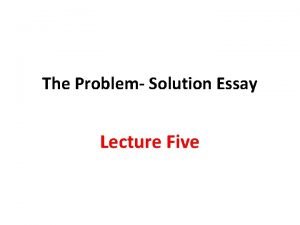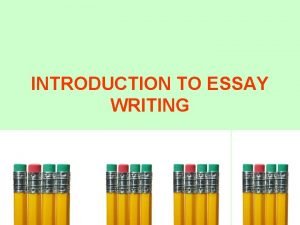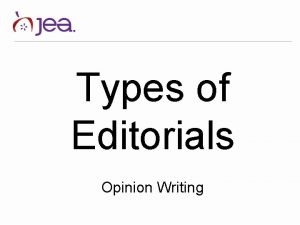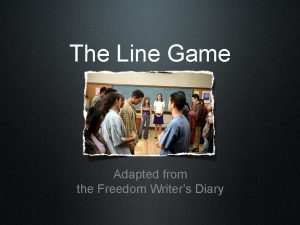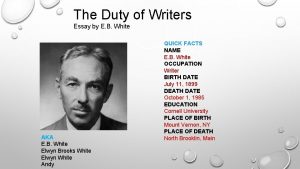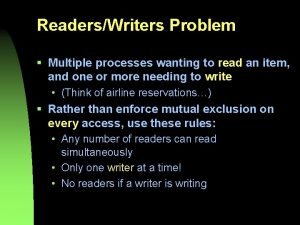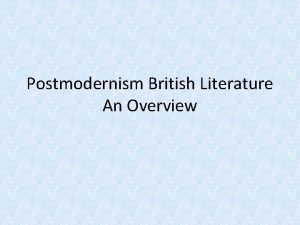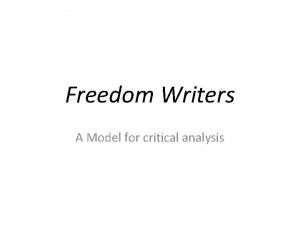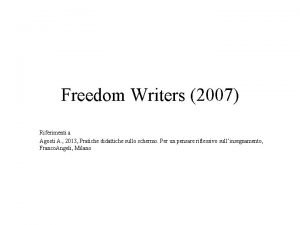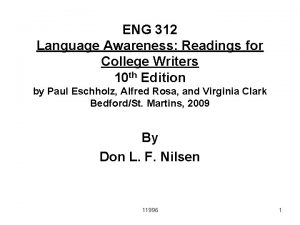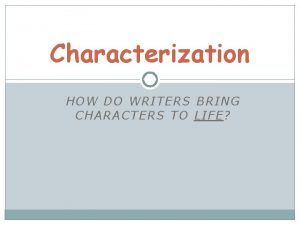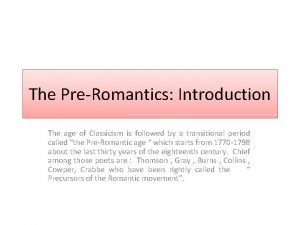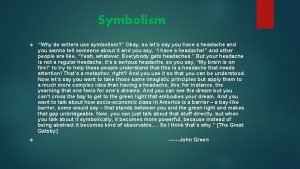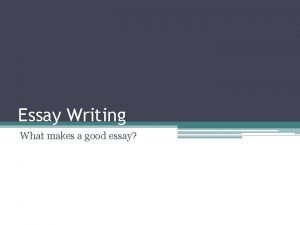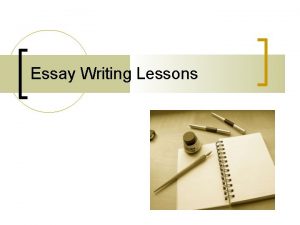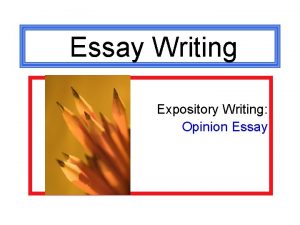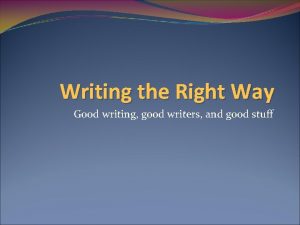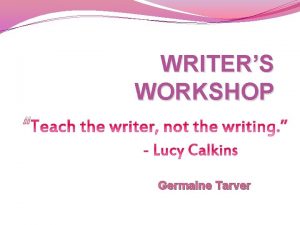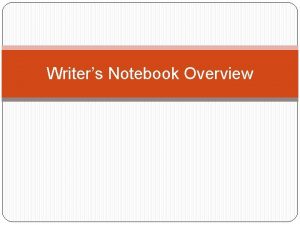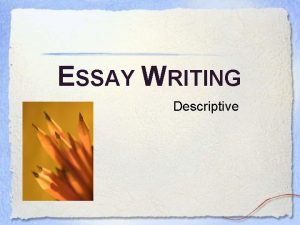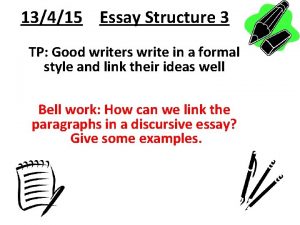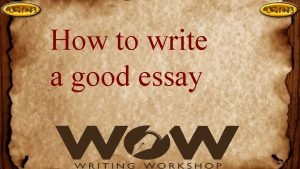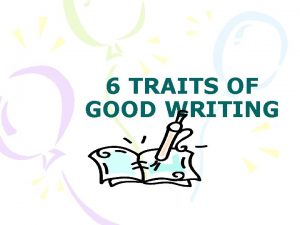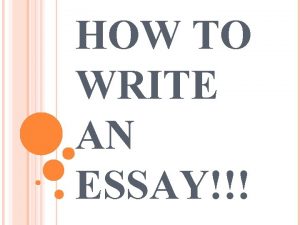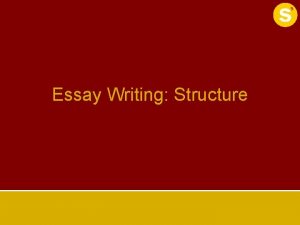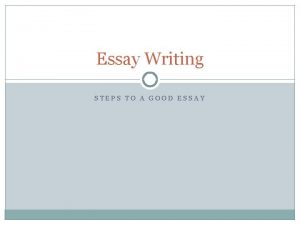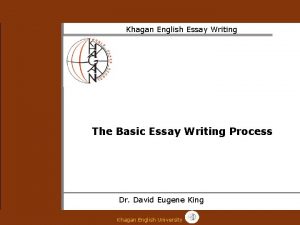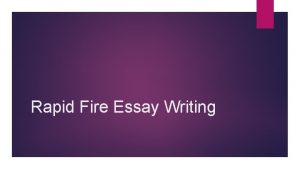INTRODUCTION TO ESSAY WRITING Good Writers Write with









































- Slides: 41

INTRODUCTION TO ESSAY WRITING

• Good Writers… – Write with purpose – Develop ideas through valid reasoning and critical thought – Provide ample, convincing evidence – Present ideas in an organized fashion – Employ appropriate voice – Follow writing conventions • What are your strengths as a writer? • What challenges do you face as a writer?

Essay Writing… What do I know about writing an essay? What do I want to (at the end of learn about writing class) What did I essays? learn about essay writing?


What is an Essay? (from Purdue University’s Online Writing Lab, Merriam Webster) • A short piece of purposeful writing that communicates the author’s thoughts and position on a particular subject • The essay is a commonly assigned form of writing that every student will encounter • essays are concise writings that require clarity in purpose and direction. ; the writing must be deliberate and interesting.

WHAT’S THE FIRST STEP TO CRAFTING A SOLID ESSAY?

Determine Your Purpose: ANALYZE THE PROMPT • Prompt • Identify the subject and direction from the prompt • Brainstorm • Purposefully collect evidentiary support • Organize the evidence into reasons • Thesis • Write your SDRS Thesis

Parts of the Essay 1. Introduction -Establishes credibility, gains reader’s acceptance -Provides thesis; this comes at the end of the introduction 2. Body -Develops ideas -Evidence is a key part of this development 3. Conclusion - Your conclusion explains the significance of your analysis as it relates to the whole

Consider the Prompts Below: • Sample SAT Prompt: “The price of greatness is responsibility. ”-Winston Churchill Do we expect too much from our public figures? Plan your response, and then write an essay. . . • Sample MCa. S Long Composition Prompt Works of literature often feature characters who overcome hardship and misfortune. From a work of literature you have read in or out of school, select a character who overcomes hardship and misfortune. In a well-developed composition, explain how the character overcomes adversity and why this success is important to the work of literature.

Consider our prompt for this essay… • Identify the subject. • Identify the direction.

Prompt P © 2008 GMM

Brainstorm B © 2008 GMM

Brainstorm B © 2008 GMM

Brainstorm B Key Point Brainstorming is the purposeful collection of building blocks for you to use to build your essay. © 2008 GMM

Organize O © 2008 GMM

PBOT T © 2008 GMM

FICTION HOUSE Pre-Writing Process: Thesis Components SUBJECT DIRECTION 3 Reasons SIGNIFICANCE Subject Prompt Brainstorm Direction Reason 1 Reason 2 Reason 3 Organize Thesis SD 3 R Thesis Significance © 2008 Galusha Meader Methods

Sample Thesis While virtually every teenager encounters conflicts with his parents, the conflicted relationship between Holden Caulfield and his parents, while not openly hostile, profoundly affects his teenage years by contributing to his isolation and sense of hopelessness. This relationship , though only occasionally discussed , plays a significant role in Salinger’s The Catcher in the Rye, as it stagnates Holden’s road to recovery.

• All American students have the right to a respectful, healthy, learning environment.


THE REST OF THE ESSAY…

THE INTRODUCTION… The introduction has two major purposes: 1) to establish credibility with the reader and gain acceptance 2) to introduce thesis

Introductory Strategies • Begin with a powerful quote that is successfully integrated into esay (be certain to place in quotation marks and cite source) • Begin with relevant background material • Begin with an analogy or extended metaphor • Sometimes it is appropriate to begin with a question, but be certain you know your instructor’s thoughts on this. Remember, whatever attention-getting strategy you select, you must make it relevant to the subject of your essay.

It might be helpful to picture your introduction as a funnel…

THE THESIS The thesis is the main focus of an essay and is the “backbone” of an essay. Thesis statement should be stated at the end of the introduction. You should write your thesis statement before writing your essay as it helps build an outline for your essay. The thesis should state the subject and direction of your essay as well as your main points. A good thesis statement also makes a statement regarding the significance or “so what” of your essay.

BUILDING THESIS: SUBJECT+DIRECTION+ REASONS+ SIGNIFICANCE When writing a thesis, you must first identify your subject and what you want to say about your Subject (the direction). This information can usually be found in your essay prompt. Next, you must identify your supporting reasons for your direction. Each of these reasons will serve as the topic for a body paragraph. Finally, end with a statement regarding the significance, or importance of our statement.

Considering Significance • When writing, consider how your thesis is meaningful to a bigger picture.

The Power of Significance: Two Thesis Statements • S+D+R’s Thesis: Andrew is a complex character as he is usually kind, but shows the capacity to be cruel. He also works hard, but does so for the wrong reasons.

The Power of Significance: Two Thesis Statements • S+D+R’s+Significance Thesis: Andrew is a complex character as he is usually kind, but shows the capacity to be cruel. He also works hard, but does so for the wrong reasons. The complexity of Andrew’s character prepares the reader for the conflicted ending of the story.

Structure is necessary for your thesis, but it should not sound formulaic! Consider…. The war in Iraq is wrong because people are dying, money is being wasted and it is hurting the military. End the war now! It is time for the war in Iraq to end. The financial cost, and more importantly, the loss of life, is damaging to our nation. Furthermore, the extended war has weakened our military. A continuation of this fight will further devastate America.

Body Paragraphs After the introduction comes the body of the essay. These paragraphs are all similarly constructed. Their topic sentences restate and develop, of the supporting ideas presented in thesis. The subtopic of each of the body paragraphs is again supported by six to Seven supporting sentences. These cement, in the reader's mind, the relevancy and relationship of each of the subtopics to thesis statement.

Evidence: The Glue of Body Paragraphs The insights in your essay must be substantiated by evidence. If you offer your reader impressive insights but give no supporting evidence, it’s like giving someone a car that looks really good, but doesn’t have an engine. The car looks nice, but it is essentially useless. Likewise if you have good ideas but fail to offer substantiating evidence, these ideas will not hold up.

The Body of the Essay Body Paragraphs- Some Reminders: • Stay organized and on topic • Include supporting quotes fluently and often • Follow all MLA guidelines for citations

Qualities of Strong, Analytical Writing Support all insights with strong, textual evidence. Remember the following about quotes: • Shorter, more frequent quotes are often more effective than long, block quotes. • All quotes and paraphrases should be presented in proper MLA format- author’s last name and page number. Ex. (Malamud 65).

Evidence: The Glue of Body Paragraphs • Provide facts, details, etc. that support you claim. Be certain that these support, rather than restate, your claim. • Provide quotations that support your assertion. If you are including random details and quotations to fill some sort of evidence quota, you are not really providing EVIDENCE, you are filling a quote quota.

• S: STATE your claim. • P: PROVIDE evidence to support your claim. • C: COMMENT on your evidence; explain how it supports claim.

Last But Not Least- The Conclusion Should… • Communicate to your reader the significance, or “so what” of your essay.

So, after the conclusion, we are done writing the essay right?

CONSIDERATIONS WHEN REVISING… Insight and Evidence= WHAT you say • • Organization and Fluency= HOW you say it

Qualities of Strong Analytical Writing

A FEW MORE REMINDERS… • Careless errors decrease the quality of your paper- proofread! Use proofreading checklists if you struggle with this. • Avoid plot summary; assume the reader of your paper has read the text. • Discuss the text using specifics rather than broad generalities. • Avoid clichés and stereotypical generalizations in your writing. • Strive to develop a voice that is unique to you.
 Good mythical morning writers
Good mythical morning writers What did renaissance writers write about?
What did renaissance writers write about? Good thoughts, good words, good deeds
Good thoughts, good words, good deeds Good afternoon
Good afternoon Good afternoon animado
Good afternoon animado If you are
If you are Good afternoon me
Good afternoon me Thematic essay example
Thematic essay example Ib hl essay thesis example
Ib hl essay thesis example Definition essay example
Definition essay example Introduction paragraph for romeo and juliet essay
Introduction paragraph for romeo and juliet essay Introduction examples for essays
Introduction examples for essays Introduction to comparative essay
Introduction to comparative essay Text response introduction example
Text response introduction example Fsa essay format
Fsa essay format Essay writing learning outcomes
Essay writing learning outcomes Writing a discursive essay
Writing a discursive essay Problem solution essay introduction
Problem solution essay introduction Descriptive writing
Descriptive writing Body paragraph structure
Body paragraph structure Types of editorial policy
Types of editorial policy How many writers of wahi
How many writers of wahi It is a french word which means rebirth
It is a french word which means rebirth The line game questions
The line game questions Writers in long beach california
Writers in long beach california The duty of writers
The duty of writers Creative writing and day dreaming
Creative writing and day dreaming Umich resume builder
Umich resume builder Northern renaissance writers
Northern renaissance writers Readers writers problem
Readers writers problem The medieval period (455 ce-1485 ce)
The medieval period (455 ce-1485 ce) Characteristics of period of activism
Characteristics of period of activism Famous british authors
Famous british authors Freedom writers synopsis
Freedom writers synopsis Freedom writers scheda didattica
Freedom writers scheda didattica Onv njanapeedam
Onv njanapeedam William shakespare
William shakespare 312زبان عشق
312زبان عشق How do writers use direct characterization in a story
How do writers use direct characterization in a story Greatest ukrainian writers
Greatest ukrainian writers Pre romantic age poets
Pre romantic age poets Why is symbolism important in literature
Why is symbolism important in literature
